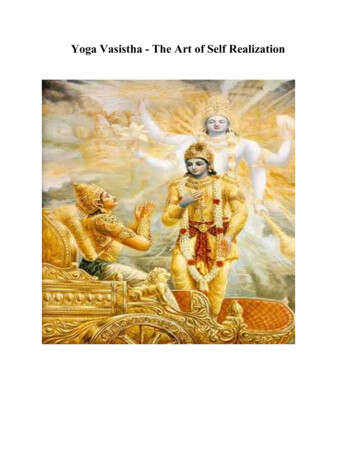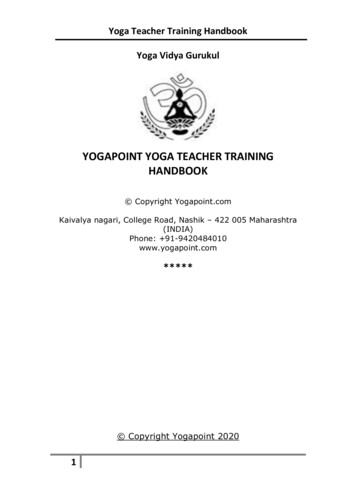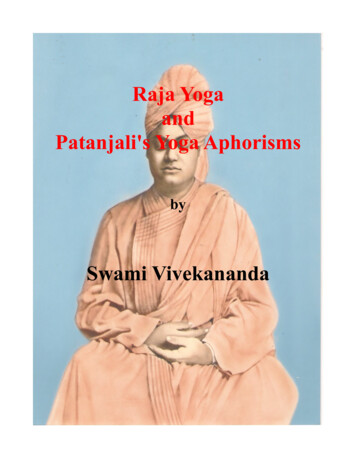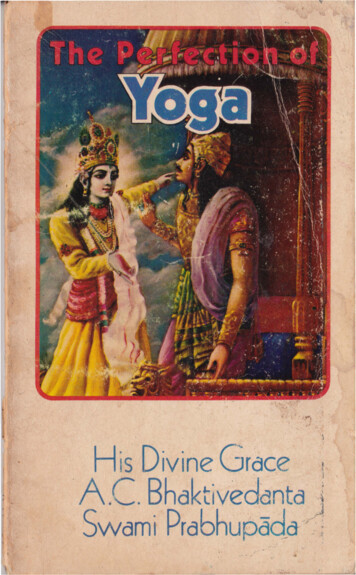
Transcription
HomeAbout AnamayaYoga Teacher TrainingAccommodationsSurfingYoga Retreats Photo GalleryContact UsYoga Glossary – Most importantyoga vocabulary words Angela GonzalezJune 4, 2012 Search OurWebsiteSearch Yoga GuideMain NavigationYoga is one of the few practices that can actually have influence your ways inlife. Even as a novice in yoga, you will immediately fall in love with themovements and the benefits of the practice. You begin to notice changes inthe way you move, what you eat and eventually the words you use. One ofthe fascinating things about yoga is when you start talking about it. To someyoga enthusiasts, this elegant ancient language adds a certain charm to thistime tested practice of yoga. Sanskrit words begin to flow and flourish fromteacher to student as most classes today are taught with the use of theSanskrit terms and their translations.CalendarYoga RetreatsYoga RetreatsRates andCalendarReserve/Inquire forRetreatsA large amount of yoga terminology is Sanskrit. Here is a brief introduction onYoga Retreatsthe Sanskrit language so that even as a new student of yoga, you may gain aVideobetter appreciation and a general understanding of its place within yoga.Yoga TeacherTrainingWhat is Sanskrit?YTTInstructorsRates &Schedule forYTTsReserve/Inquire for YTTsVideo forYTTsSurfingSurfing
Sanskrit is confirmed toRates &be the oldest languageSchedulesknown to man.BookingAccording to DiscoverFormYoga Online, all otherPricinglanguages started fromRetreatevolving from it. It isPricingsaid to be the veryYTT Ratesorigin of language itself.The classical text ofyoga was written using the Sanskrit language. The Vedanta or the Vedaswhich are said to be the first spiritual scriptures were also written in Sanskrit.Today, a great number of historical texts that was written in this ancientlanguage even from vast studies of astrology, astronomy, medicine,architecture are still found.In order deepen your understanding and guide you through your practice, atsome point it would be very helpful to learn these commonly used words.I’ll start by saying “Namaste”“Namaste.” According to yoga teacher Aadil Palkhivala of Yoga Journal ,literally means “I bow to you.”AAcarya (sometimes spelled Acharya in English): a preceptor, instructor; guruAdvaita (non-duality): the truth and teaching that there is only one realityAhimsa (non-harming): the single most important moral discipline (yama)Ananda (bliss): the condition of utter joy, which is an essential quality of theultimate realityAnga (limb): a fundamental category of the yogic path, such as asana,dharana, dhyana, niyama, pranayama, pratyahara, samadhi, yama;Ardha (half)More InfoThe ResortAccommodationsMap ofAnamayaPoolSpa &MassageWaterfalland TrailsMapYoga rtual TourBlog & ArticlesCuisineFAQ'sPressCoverageStaff and JobsTestimonialsTravel &Directions
Asana (seat): a physical posture; the third limb (anga) of Patanjali’s eightfoldpath (astha-anga-yoga); originally this meant only meditation postureAshrama (that where effort is made): a hermitage; also a stage of lifeTripAdvisorReviewsWeather inMontezumaAtman (self): the transcendental Spirit, which is eternal and; our true nature oridentityAvidya (ignorance): the root cause of sufferingAyurveda, Ayur-veda (life science): one of India’s traditional systems ofmedicinePermaculture YogaBClasses at our Farm!Bandha (bond/bondage): the fact that human beings are typically bound byignorance which causes them to lead a life governed by karmic habit ratherthan inner freedom generated through wisdomBhagavad Gita (Lord’s Song): the oldest yoga book found embedded in theMahabharata Bhakta (devotee): a disciple practicing bhakti yogaAnamaya Virtual Tour –360 Bhakti (devotion/love): the love of the bhakta toward the DivineBhakti Yoga (Yoga of devotion): a major branch of the yoga tradition.Bindu (seed/point): the creative potency of anything where all energies arefocused; the dot (also called tilaka) worn on the forehead as indicative of thethird eyeBrahma (Creator): the Creator of the universeBrahmacharya (from brahma and acarya “brahmic conduct”): the discipline ofchastityBrahman (The Supreme Atman): the ultimate RealityBrahmana or Brahmin: a member of the highest social class of traditionalIndian society
CCakra or Chakra (wheel): literally, the wheel of a wagon.DDarshana (seeing): vision in the literal and metaphorical sense; a system ofphilosophy.Dharana (holding): practice of concentration, the sixth limb (anga) ofPatanjali’s eight-limbed yogaDhyana (ideating): meditation, the seventh limb (anga) of Patanjali’s eightlimbed yogaDharma (religious path)Diksha (initiation): the act and condition of induction into the hidden aspectsof yoga or a particular lineage of teachers; all traditional yoga is initiatoryDrishti (view/sight): yogic gazing, such as at the tip of the nose or the spotbetween the eyebrowsGGayatri-mantra: a famous Vedic mantra recited particularly at sunrise:Guna (quality): a term that has numerous meanings, including “virtue”Guru (spiritually enlightend soul): a spiritual teacher;Guru-bhakti (teacher devotion): a disciple’s self-transcending devotion to theguruGuru-Gita (Guru’s Song): a text in praise of the guru, often chantedin ashramasGuru-Yoga (Yoga [relating to] the teacher): a yogic approach that makes theguru the fulcrum of a disciple’s practice
HHatha Yoga (Forceful Yoga): a major branch of yoga, emphasizing thephysical aspects of the transformative path, notably postures (asana) andcleansing techniques (shodhana), but also breath control(pranayama)Hatha-Yoga-Pradipika (“Light on Hatha Yoga”): one of three classical manualson hatha yoga, authored by Svatmarama Yogendra in the fourteenth centuryIIda-nadi (pale conduit): the prana current or arc ascending on the left side ofthe central channel (sushumna nadi) associated with the parasympatheticnervous system and having a cooling or calming effect on the mind whenactivatedIshvara (ruler): the Lord; referring either to the CreatorIshvara-pranidhana (dedication to the Lord): Devotion to the Lord.JJapa (speak softly) the recitation of mantrasJiva-atman, jivatman (individual self): the individuated consciousness, asopposed to the ultimate Self (parama-atman)Jnana (knowledge/wisdom): both worldly knowledge or world-transcendingwisdom, depending on the contextJnana-Yoga (Yoga of wisdom): the path to liberation based on wisdomKKaivalya (isolation): the state of absolute freedom from conditioned.K
Kali: a Goddess embodying the fierce (dissolving) aspect of the DivineKali-yuga: the dark age of spiritual and moral decline, said to be current now;kali does not refer to the Goddess Kali but to the losing throw of a dieKama (desire): the appetite for sensual pleasure blocking the path to trueblissKapal(skull):cerebrumKarman, karma (action): activity of any kind.Karma Yoga (Yoga of action): the liberating path of self-transcending actionKaruna (compassion): universal sympathy.Kosha (casing): any one of five “envelopes” surrounding the (atman)Kumbhaka: breath retention.Kundalini-Yoga: the yogic path focusing on the kundalini process as a meansof liberationMMaha (great)Maha bandha(the Great lock) combines the three locks in yoga – togetherwith breath retentionMahabharata (Great Bharata): one of India’s two great ancient epics telling ofthe great war between the Pandavas and the Kauravas and serving as arepository for many spiritual and moral teachingsMahatma (from maha-atman, “great self”): an honorific tittleManas (mind): the mind, which is bound to the senses and yields informationrather than wisdomMandala (circle): a circular design symbolizing the cosmos and specific to adeity
Mantra (from the verbal root man “to think”): a sacred sound or phrase.Mantra-Yoga: the yogic path utilizing mantras as the primary means ofliberationMaya (she who measures): the deluding or illusive power of the world.Moksha (release): the condition of freedom from ignoranceMudra (seal): a hand gesture or whole-body gestureMuni (he who is silent): a sageNNadi (conduit): one of 72,000 or more subtle channels along or through whichthe life force (prana) circulates, of which the three most important ones arethe ida-nadi, pingala-nadi, and sushumna-nadiNadi-shodhana (channel cleansing): the practice of purifying the conduits,especially by means of breath control (pranayama)Nirodha (restriction): in Patanjali’s eight-limbed yoga, the very basis of theprocess of concentration, meditation, and ecstasy.Niyama ([self-]restraint): the second limb of Patanjali’s eightfold pathOOjas (vitality): the subtle energy produced through practice, especially thediscipline of chastity (brahmacharya)Om: the original mantra symbolizing the ultimate Reality, which is prefixed tomany mantric utterancesPPada (foot)
Padmasana (lotus pose): a seated meditative postureParama-atman or paramatman (supreme self): the transcendental SelfParama-hamsa, paramahansa (supreme swan): an honorific title given togreat adeptsPatanjali: compiler of the Yoga Sutra, who lived c. 150 C.E.Pingala-nadi (reddish conduit): the prana current or arc ascending on the rightside of the central channel (sushumna-nadi) and associated with thesympathetic nervous system and having an energizing effect on the mindwhen activated.Prana (life/breath): life in general; the life force sustaining the body; thebreath as an external manifestation of the subtle life forcePranayama (from prana and ayama, “life/breath extension”): breath control,the fourth limb (anga) of Patanjali’s eigthfold pathPrasada (grace/clarity): divine grace; mental clarityPratyahara (withdrawal): sensory inhibition, the fifth limb of Patanjali’seightfold pathPuja (worship): ritual worship, which is an important aspect of many forms ofyoga.Puraka : inhalation, an aspect of breath controlPurana (Ancient [History]): a type of popular encyclopedia dealing with royalgenealogy, cosmology, philosophy, and ritual; there are eighteen major andmany more minor works of this natureRRaja-Yoga (Royal Yoga): a late medieval designation of Patanjali’seightfold yoga-darshana, also known as classical yogaRama: an incarnation of Krishna; the principal hero of the RamayanaRamayana (Rama’s life): one of India’s two great national epics telling the
story of RamaRecaka: exhalation, an aspect of breath controlRishi (seer): a category of Vedic sage; an honorific title of certain veneratedmasters.SSadhana (accomplishing): spiritual discipline leading to siddhiSamadhi (putting together): the ecstatic or unitive state in which the meditatorbecomes one with the object of meditation, the eighth and final limb (anga) ofPatanjali’s eightfold path;Samsara (confluence): the finite world of change, as opposed to the ultimateRealitySamskara (activator): the subconscious impression left behind by each act ofvolition,Sat (being/reality/truth): the ultimate RealitySatya (truth/truthfulness): truth, a designation of the ultimate Reality; also thepractice of truthfulness, which is an aspect of moral disciplineShakti (power): the ultimate Reality in its feminine aspect.Shishya (student/disciple): the initiated disciple of a guruShodhana (cleansing/purification): a fundamental aspect of all yogic paths; acategory of purification practices in hatha yogaShraddha (faith): an essential disposition on the yogic pathShuddhi (purification/purity): the state of purity; a synonym of shodhanaSiddhi (accomplishment/perfection): spiritual perfection, the attainment offlawless identity with the ultimate Reality (atman or brahman); paranormalability, of which the yoga tradition knows many kinds
TTapas (heat): austerity, penance, which is an ingredient of all yogicapproaches, since they all involve self-transcendenceUUpanishad (sitting near): a type of scripture representing the concludingportion of the revealed literature of HinduismYou May Also LikeVinyasa KramaYoga PosesMy Life ChangingYTT ExperienceWhat to Look forin a Great YogaTeacher TrainingAnanda YogaPracticeVinyasa FlowBenefitsYoga TeacherCertificationVinyasa FlowTeacher TrainingContact Anamaya ResortHomeTerms of Serviceand Retreat Center
Yoga Glossary – Most important yoga vocabulary words Angela Gonzalez June 4, 2012 Yoga Guide Yoga is one of the few practices that can actually have influence your ways in life. Even as a n










